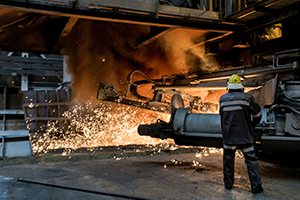Departments within companies and corporates in every sector are feeling the macro changes brought about by Industry 4.0 and AI. Here’s how you should adapt to AI if you want to stay at the top, with 6 insights to improve your production performance
1. Keep the know-how across generations
The power of AI gives incredible results either as a decision aid tool through recommendations or as an exceptional pattern recognition instrument for root cause analysis. AI-assistants are fast becoming crucial to achieve more using what’s already existing (i.e. workforce, production means, …) in highly competitive sectors, when human errors are common or have dangerous implications (for example in the heavy industry), and when skilled workers are hard to find or retiring without replacement. With an aging baby boom generation, it is estimated that up to 50% of engineers could retire within a decade, which puts pressure on companies to conserve their know-how in the short term. By centralizing this knowledge, discerning patterns while keeping in mind a large set of examples, AI can concretely help current and future generations of engineers in their daily jobs.
2. Combine personalization and mass-production with AI
Craftsmen were previously able to personalize their products and services for their client, but in small batches only. Industrialization enabled the mass-production of products with standardization, but at the loss of personalization. With AI, we can at last personalize products and services while keeping the advantages of mass production: for example, smartphone assistants are able to bring personalized answers to billions of people every day. In the future, personalized medicine could in effect bind every human to a dedicated virtual doctor that knows what works for their specific body. In a production setting, AI could help to better organize production to service customers with the exact final product they need (such as a specialized steel for aerospace) while keeping R&D and production costs down.
3. Push the barrier of optimization
Continuous improvement isn’t a new concept, and humans always tested new ways to perfect the existing processes. But the human brain capacity to consider multiple dimensions and traditional rule-based theory-building are making enhancement incrementally harder, with diminishing returns. IT, automation and classical computing helped pushed yields to new heights in the 3rd industrial revolution, and AI technologies such as machine learning and deep learning are now finding new paths of advancements. In the manufacturing space, AI is bringing large gains in quality sustainability, maintenance, energy consumption and yield in general.
4. Innovate faster and safer
Apart from being a problem-solving expert, AI is also a fantastic helper to innovate more and at a faster pace: it can improve processes and dynamically fine-tune the manufacturing recipes according to the raw material and the current state of machines on the lines, but also simulate how changes can achieve your goals before you try it on physical production lines, and help you to develop novel products. AI is also a useful tool to bring to light new business models, as automobile manufacturers who are developing new mobility solutions with self-driving cars.
5. Get AI to help every part of your company, down to individual employees
Almost every job will change with AI and will benefit from this technology. It will be easier for some profiles such as engineers, who are already problem-solvers and used to the scientific method that is the basis of data science. What’s urgent for companies on the way to Industry 4.0 is to set up new departments specialized in AI and data science, or extend the capacities of R&D departments with experts in these fields. Such innovation teams, incorporating data science, AI experts and employees from all other departments should have a transversal view of the company and build the AI tools that assist every department and employee in their daily jobs. On the data engineering side, these innovation teams will have to train or hire specific profiles such as data managers, governance specialists, and cloud experts. With AI and humans working together to achieve the same goal, barriers to total efficiency will be brought down one by one.
6. Optimize the global production while achieving climate and environment goals
The fact that AI can get the big picture will allow closer interactions and a global optimization of the world economy, more respectful of the environment, starting with an perfect tracking and management of multiple production lines, then multiple factories, then dynamic reconfigurations of machines and lines, and at last full efficiency across an integrated complete supply chain, from raw material extraction, to procurements, sales, logistics and final delivery to the customers, with almost zero quality issue, delay, scrap. You’ll also need significantly less stock inventory with improved just-in-time production.


